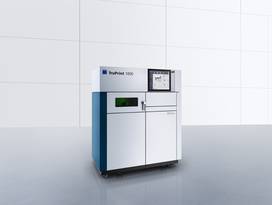The 2017 Laser Additive Manufacturing (LAM) Workshop in Houston brings together top researchers and industry leaders to discuss the latest advancements in additive manufacturing. In preparation for this year’s event, Lasers Today takes a closer look at the workshop’s presenters and innovators.
The global market leader in state-of-the-art metal powder solutions, LPW Technology, are now the proud owners of a TRUMPF TruPrint 1000, an innovative metal additive manufacturing machine that produces small metal components through laser melted fusion. TRUMPF is the largest manufacturer of fabricating equipment and industrial lasers in North America, with an increasing focus on growing additive manufacturing needs, as evidenced by the TruPrint series of machines.

TRUMPF’s TruPrint 1000
What TruPrint 1000 Will Do for Additive Manufacturing Research
The TRUMPF TruPrint 1000 is expected to enhance LPW’s already impressive research and development capabilities. The machine will allow for greater novel alloy development, applications testing, the study of powder degradation, optimize processes and lead to new research projects. The TruPrint offers a standardized user interface and software program, covering all aspects of the production process from design to finished part. The TruPrint 1000 includes a 200 W Fiber Laser, capable of processing parts made of stainless steel, aluminum, nickel-based alloys, and bronze, just to name a few.
In simpler terms, the TruPrint 1000 will help LPW and the additive manufacturing community through a streamlined process and unprecedented data collection. TRUMPF recognizes the growing need for accurate data throughout the additive manufacturing process. When companies, such as LPW Technology are able to harness this data, potential problems can be addressed before the parts go to print. As a result, parts are developed with greater integrity, and at a faster rate.
The addition of the TruPrint 1000 goes hand in hand with LPW’s development of a new metal additive manufacturing lab. Acquiring new equipment, such as TruPrint 1000, enables LPW to further the development of the PowderLife system. Allowing for the strict control of risk and traceability for parts manufacturers, PowderLife is a combination of software, hardware, support, and testing pioneered by LPW Technology. Between the equipment solutions created by TRUMPF and the systems developed by LPW, valid metal powder control processes that benefit users of laser powder bed fusion additive manufacturing, are closer than ever before. Furthermore, the streamlining and simplification of these processes lay the groundwork for addressing other challenges, such as those posed by medical applications of 3D printed parts.
Solving Challenges within Medical Additive Manufacturing
With stronger processes to synthesize data, as well as systems in place to control risk and traceability, the future for medical additive manufacturing applications is bright.
Laser Metal Fusion, sometimes referred to as Selective Laser Melting, is a preferred additive manufacturing method for parts intended for medical use. The method allows for complex features, with nearly unlimited design capabilities. Parts created using laser metal fusion are typically low-weight, stabilized, and inexpensive, making them excellent candidates for artificial hips, and other implants.
The TruPrint 1000 gives the flexibility and feasibility for elaborate parts to go into production quickly and cost-effectively, through its laser metal fusion capabilities. The time from design to prototype is fractionalized, giving greater opportunities for research of medical applications.
Learning More at LAM 2017
Representatives from LPW Technology and TRUMPF will be presenting at LAM 2017. Be sure to catch Nathan Kistler of LPW discussing “Characterizing and Managing Metal Powders in AM Service” as part of the Materials for Additive Manufacturing Session. Frank Geyer of TRUMPF will present “Metal Powder Based AM- New Applications” as part of the final of two Additive Manufacturing Applications sessions. Plan your visit to LAM with the advance program here.
Want to learn more about the recent developments within the world of additive manufacturing? Registration is still open! For more information and to register, please visit: https://www.lia.org/conferences/lam.
